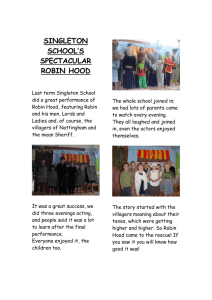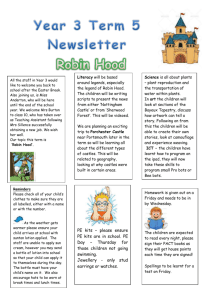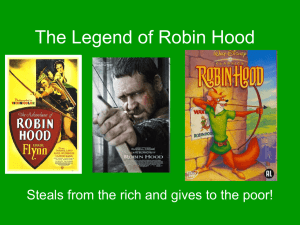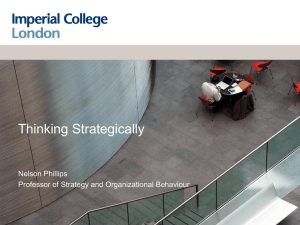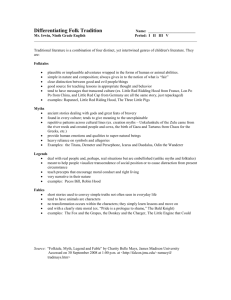Robin Hood Foundation Case Study
advertisement
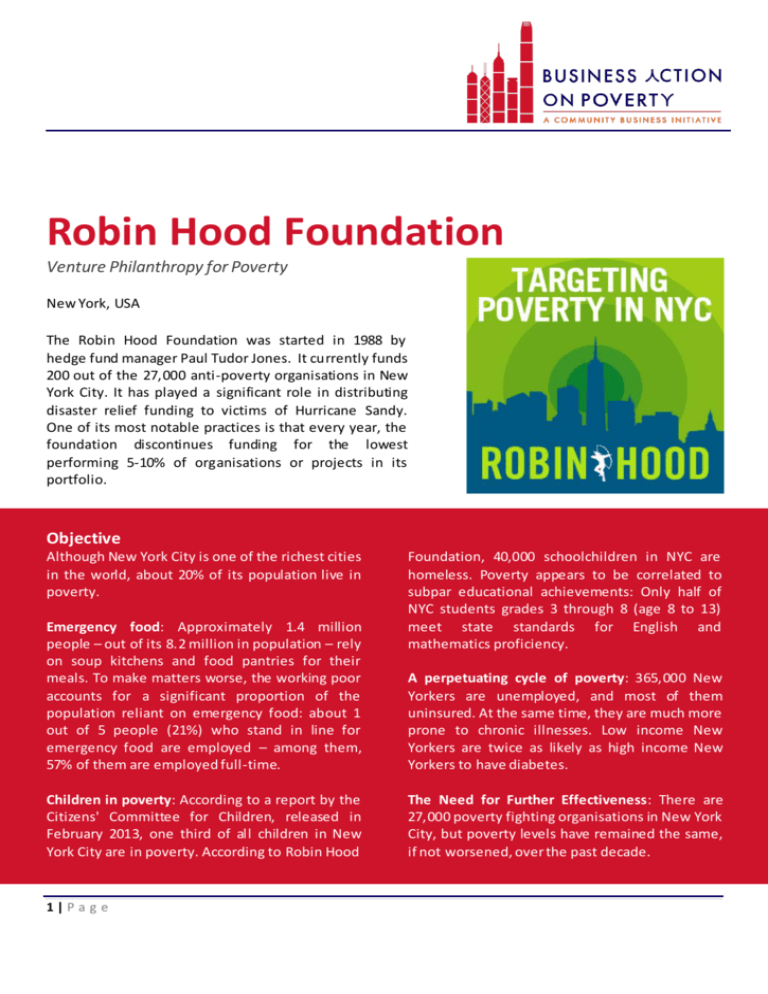
Robin Hood Foundation Venture Philanthropy for Poverty New York, USA The Robin Hood Foundation was started in 1988 by hedge fund manager Paul Tudor Jones. It currently funds 200 out of the 27,000 anti-poverty organisations in New York City. It has played a significant role in distributing disaster relief funding to victims of Hurricane Sandy. One of its most notable practices is that every year, the foundation discontinues funding for the lowest performing 5-10% of organisations or projects in its portfolio. Objective Although New York City is one of the richest cities in the world, about 20% of its population live in poverty. Emergency food: Approximately 1.4 million people – out of its 8.2 million in population – rely on soup kitchens and food pantries for their meals. To make matters worse, the working poor accounts for a significant proportion of the population reliant on emergency food: about 1 out of 5 people (21%) who stand in line for emergency food are employed – among them, 57% of them are employed full-time. Children in poverty: According to a report by the Citizens' Committee for Children, released in February 2013, one third of all children in New York City are in poverty. According to Robin Hood 1|Pa g e Foundation, 40,000 schoolchildren in NYC are homeless. Poverty appears to be correlated to subpar educational achievements: Only half of NYC students grades 3 through 8 (age 8 to 13) meet state standards for English and mathematics proficiency. A perpetuating cycle of poverty: 365,000 New Yorkers are unemployed, and most of them uninsured. At the same time, they are much more prone to chronic illnesses. Low income New Yorkers are twice as likely as high income New Yorkers to have diabetes. The Need for Further Effectiveness: There are 27,000 poverty fighting organisations in New York City, but poverty levels have remained the same, if not worsened, over the past decade. Model Robin Hood Foundation embodies the venture philanthropy model in tackling poverty issues. It applies the principles of financial investment to the grant process. Impact is the main criterion for receiving funding – grants are allocated to maximize impact, in the same way that a financial manager chooses investments to maximize profit. Potential grantees are required to set specific, quantifiable goals and to achieve them in a certain time frame. Every year, the lowest performing 5-10% of grantees are at risk of having their funding withdrawn. Similar to the portfolio companies of a private equity fund, grantees who perform well receive additional resources to scale up their operations. Additional support comes in the form of pro bono services from the partners of the Robin Hood Foundation, and includes strategic planning, marketing, finance, technology and legal assistance. childhood education as one of its focuses. It has found that attending pre-kindergarten (pre-K) programmes increases the chance of high school graduation by 15%. Robin Hood invests in pre -K programmes designed to fight poverty at the earliest age possible. According to Robin Hood Foundation, pre-K programmes “[reverse] speech and language delays and [ensure] that children are better prepared to learn in kindergarten and beyond.” The vast financial resources available for the Robin Hood Foundation allow the organisation to take a more comprehensive and multi-pronged approach in tackling poverty. For example, in its work of enhancing economic security, apart from job training it also funds and supports the growth of programmes that provide the poor with financial and legal counselling, free banking services, and loans and technical guidance in starting a business. Based on a data-heavy and results-oriented approach, Robin Hood has identified early Impact 55,000 students reached by Robin Hood's education initiatives in 2011. 12,000 individuals received job training. Over 5 million meals provided yearly. 35,000 New Yorkers received health care services from Robin Hood grantees. According to Robin Hood Foundation: “92% of people who enter a Robin Hood funded housing programme do not return to shelters.” “Robin Hood programmes increase the chance of passing the GED [secondary school qualification] by 75%.” “Robin Hood's job training programmes are twice as effective as others, yielding higher salaries and job retention rates than other city funded programmes.” 2|Pa g e Impact Continued At least two organisations in the US, Boston Rising in Boston and Tipping Point in San Francisco, have be en modelled after Robin Hood Foundation, with varied success. The focus on continuous fundraising has proven to be a key factor to success of the venture philanthropy model. The work of Robin Hood Foundation had been questioned because of its high society affiliations. The way it invests its funds, which involves hedge funds and management fees paid out to fund managers, has also come under scrutiny. However, none of these criticisms has proven to have a long-term negative effect on the strong and rising reputation of Robin Hood Foundation. 3|Pa g e Sources: Robin Hood Foundation website, http://www.robinhood.org. "Modern day Robin Hood applies business skills to philanthropy”, CBS '60 Minutes' feature, http://www.cbsnews.com/video/watch/?id=50146230n, May 5, 2013. "One third of NYC children live in poverty, says report”, The Queens Courier, Feb 13, 2013, http://queenscourier.com/2013/study-one-third-of-nyc-children-live-in-poverty/. “Rising and Falling”, The Boston Globe, June 9, 2013, http://www.bostonglobe.com/metro/2013/06/08/rising-andfalling/6xTtnkeTj0frxJyxFPIpvJ/story.html. “Altruist's latest gift is a wake-up call,” Sydney Morning Herald, June 11, 2013, http://www.smh.com.au/national/altruistslatest-gift-is-a-wakeup-call-20130610-2o05l.html. Frank, Robert, "Is Robin Hood Robbing the Poor?”, Wall Street Journal, July 18, 2007, http://blogs.wsj.com/wealth/2007/07/18/is-robin-hood-robbing-the-poor/ Gordon, Meryl, “The Green Team”, New York Magazine, 2000 (Date not specified). http://nymag.com/nymetro/news/culture/features/3374/ Levin, Bess, “Robin Hood Fund Pulls Investment from Hedge Fund Managers”, Dealbreaker, 19 July 2007, http://dealbreaker.com/robin-hood-foundation/. Community Business (CB) is a unique membership based non-profit organisation dedicated to advancing Corporate Social Responsibility (CSR) in Asia. Our mission is clear: to lead, inspire and support businesses to improve their positive impact on people and communities. We work with some of the world’s leading companies along their CSR journey and specifically focus on four key areas of CSR: Community Investment (CI), Work-Life Balance (WLB), Diversity and Inclusion (D&I) and CSR Strategy. 4|Pa g e Business Action on Poverty is an initiative launched by Community Business and its member companies. Represented by senior level executives, this group of companies has committed to a long-term strategy focused on impacting positive change towards the alleviation of poverty in Hong Kong. For more information about our program please visit: http://www.businessactiononpoverty.org.hk Or Contact: BAOP@communitybusiness.org
